By Kirsten J. Barnes
CCBP Graduate Assistant
[ Complete text of Cochran’s speech ]
[ Video of Banquet ]
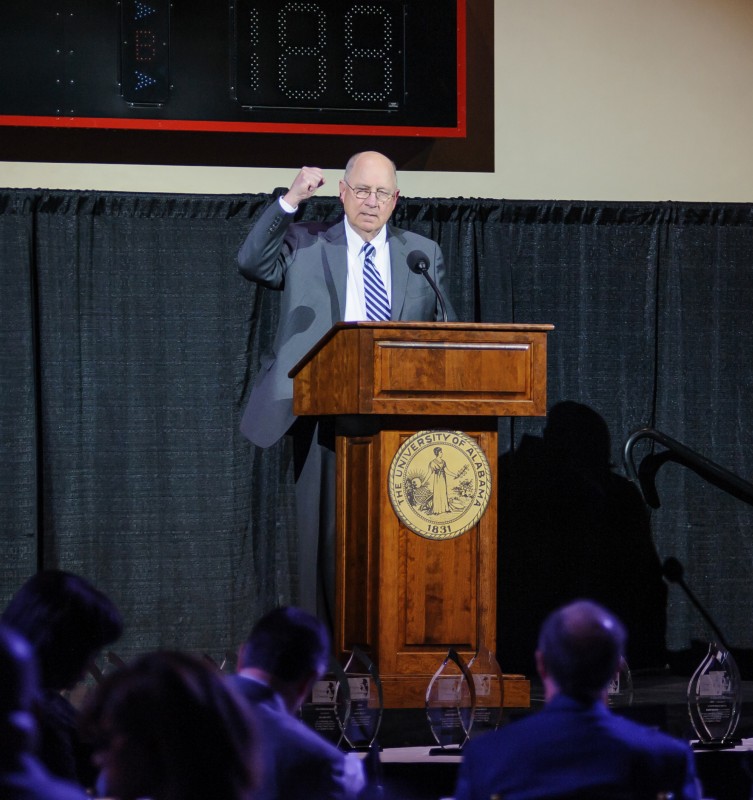
Three-time Emmy Award-winner John Cochran, a premier network correspondent for almost 50 years, knows first-hand the impact the Rev. Martin Luther King Jr. had on the state of Alabama and, most notably, his hometown of Montgomery.
“I was lucky enough to have been born in Montgomery before the civil rights struggle really broke out,” Cochran, who’ll be 75 on March 15, told 300 people in historic Foster Auditorium attending the 25th Annual Realizing the Dream Legacy Banquet.
Cochran captivated the audience with his firsthand, culturally sensitive story about his family’s African-American maid named Arrie, who worked for them during the mid-1950s, simultaneously weaving in information about Rosa Parks and the Montgomery Bus Boycott.
“I’ve been around presidents and prime ministers and captains of industry, but I have never known anyone with more dignity than Arrie,” said Cochran, recalling Arrie as a mid-50s, well-spoken, well-dressed, intelligent woman.
Cochran reminded the audience that although the U.S. Supreme Court had already outlawed segregation on interstate travel, Alabama state and municipal buses were still segregated.
“(Rosa Parks) and others in the Civil Rights Movement had wanted a test case in the courts to challenge the state law requiring segregated seating,” Cochran said. “Black leaders wanted not only a test case; they also wanted to test the resolve of white merchants by putting economic pressure on the white establishment.”
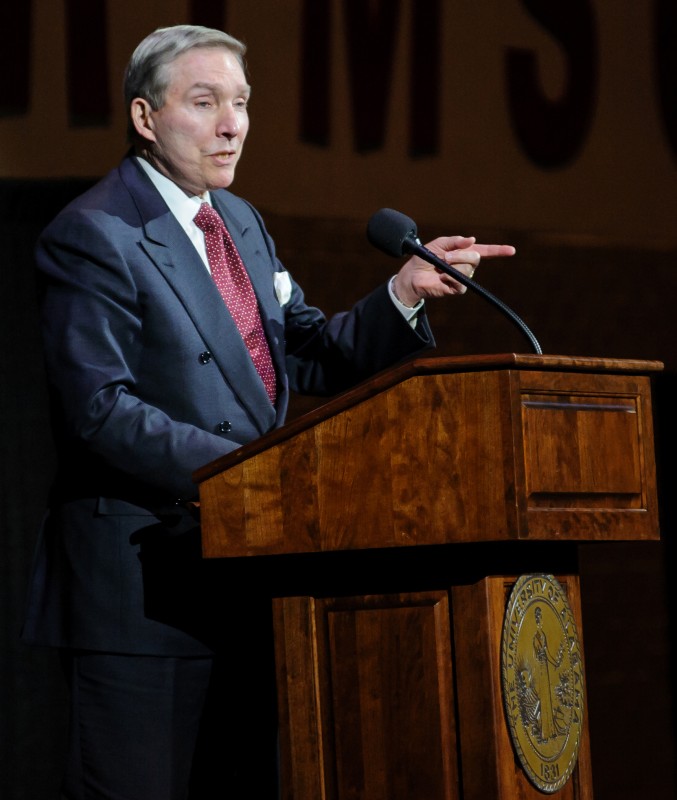
On Dec. 1, 1955, the day Parks refused to give up her seat to a white rider, the bus boycott began. However, many do not understand how it affected blacks and whites in Montgomery.
When blacks stopped using buses, they could not get to white-owned merchants to buy things and many domestic workers could not get to or from work.
Until the boycott, Arrie used city buses for transportation to and from work. Arrie told the Cochrans she planned to do whatever Dr. King told her to do and that meant participating in the boycott. Though she had found a ride to work, she had no way home. It was up to the Cochrans to find a solution, which turned out to be, as Cochran said, “Me. I had just gotten my driver’s license. So, every day after I got out of school it became my job to driver Arrie home.”
For the first few weeks Cochran sat behind the wheel while Arrie sat in back. He said it was the reverse of the Academy Award winning-movie “Driving Miss Daisy.” This time the black person was in the back and the white person in the front.
“That’s the way it was supposed to be in the South. Blacks and whites were never supposed to sit together. It was a rule — not a law — … an unspoken rule, but a rule nevertheless,” Cochran said. “That went on for a few weeks until one day Arrie and I were walking out to the car and Arrie stopped, turned to me and said, ‘Johnny, I’m going to sit up front with you…’.”
As they sat beside each other each day they drove through his neighborhood, a white neighborhood, and then through her neighborhood, a black neighborhood. Immediately, both whites and blacks alike stopped to stare at them as they passed.
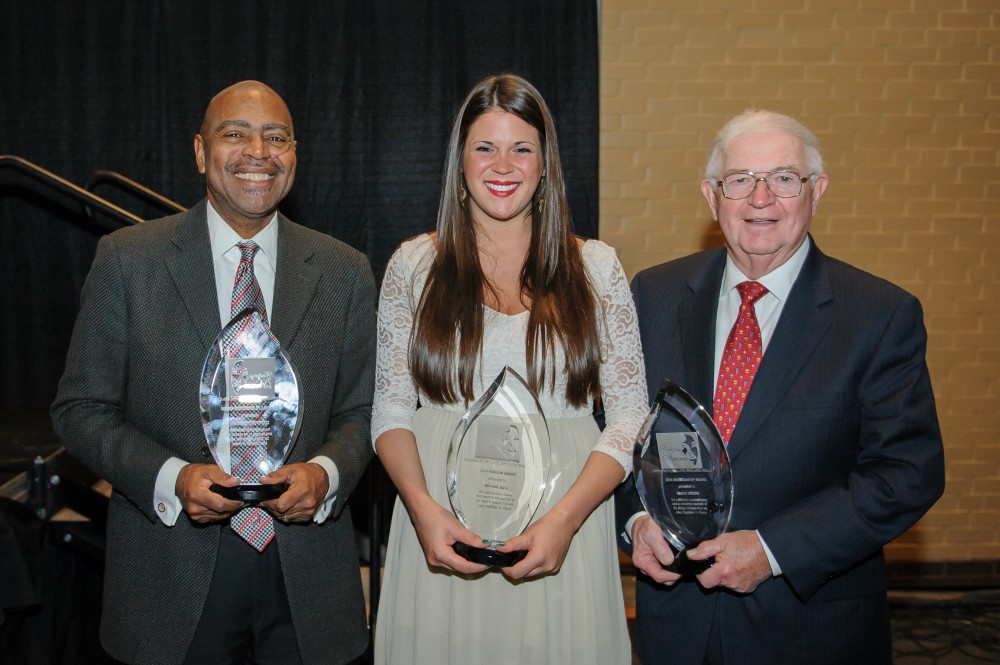
“This went on for a couple of months,” Cochran said. “Then one day Arrie and I noticed no one was paying attention anymore. People had grown accustomed to seeing us. The rule was no longer a rule.”
On June 13, 1956 the U.S. Court for the Middle District of Alabama ruled segregation was unconstitutional under the Fourteenth Amendment, which guarantees protections for equal treatment.
However, the state and city appealed this ruling, and on Dec. 17, 1956 the U.S. Supreme Court upheld the lower court’s decision in Browder v. Gayle; and three days later the court demanded Alabama desegregate its buses.
“It was a total victory for Dr. King, but it did not come easily,” Cochran said. “Many blacks — literally — wore out their shoes walking either to work or to school, houses were bombed, Dr. King and others were put in jail, some blacks lost their jobs because white employers were vengeful, and some, like Arie, thought they might lose their jobs, but went ahead anyway.”
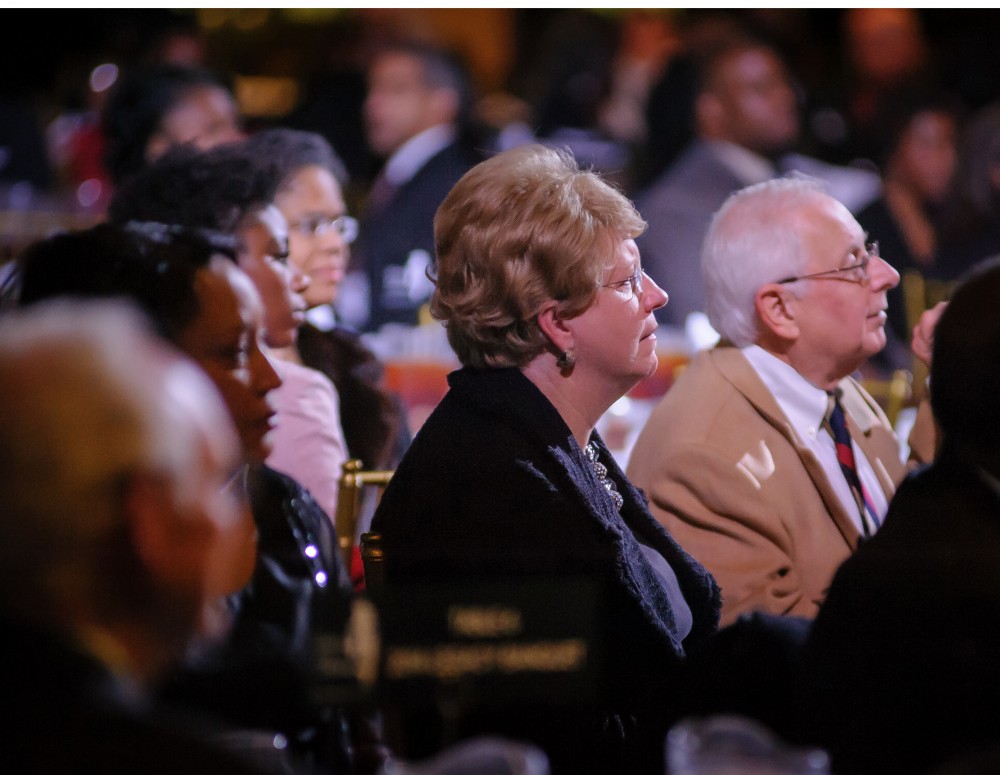
Later, Cochran described his sister’s failed efforts to integrate First Baptist Church in Montgomery with the Rev. David Abernathy, after hearing King speak. “No history was made that day, but I was proud of her for trying,” Cochran said of his sister, Mary Ann.
He then moved to the failed efforts to integrate UA by Autherine Lucy in 1956 and the failed efforts of then Gov. George Wallace, who attempted to keep Vivian Malone and James Hood from registering for classes at Foster, the very building the event was being held in.
“I crossed paths with Wallace several times over the years,” Cochran said, recalling the transformation of Wallace from a segregationist to a more caring person who worked to make amends for his transgressions.
Several attendees commented how apropos Cochran’s speech was. And Dr. Samory Pruitt, vice president of community affairs, said, “As I look around this room I see people who have been here almost every year we’ve done this,” said Dr. Samory Pruitt, vice president of Community Affairs. “We were honored to have had as the keynote speaker, Mr. John Cochran. His speech was riveting and remarkable.”
Dr. Ed Mullins, former dean of the UA College of Communication and Information Sciences and now a director within Community Affairs, introduced Cochran after another former dean of that same college, Dr. E. Culpepper (Cully) Clark, set the historical stage for Cochran’s remarks. Clark is the author of the definitive book on the integration of the University, The Schoolhouse Door: Segregation’s Last Stand at the University of Alabama.
This was the 25th anniversary of the Legacy Banquet. It began in 1990, hosted then as now by Stillman College, Shelton State Community College, the Southern Christian Leadership Conference, and The University of Alabama.
Pruitt shared the following message he sent to Cochran in an email after the banquet:
“Thank you for agreeing to serve as the speaker for the Legacy Banquet commemorating the 25thAnniversary of the formation of the Realizing the Dream Committee, and for providing us with the text of your speech. As I mentioned to you and Barbara (Cochran’s wife) on last Friday, you were our first and only choice as speaker. We continue to receive emails and comments about the remarkable and historic speech you gave during the banquet. Again, thanks.”
Earlier, Wendel Hudson, former UA women’s basketball coach, the first African American to receive an athletic scholarship, told of his experience as a pioneer of integration.
After Cochran’s speech, videos were shown and the 2014 Legacy Banquet honorees were recognized as follows:
• Melanie Gotz, Horizon Award, for her leadership in the fight to open traditionally white social fraternity organizations to all races.
• Cleophus Thomas, Call to Conscience Award, for his community and public leadership in race relations.
• Dr. Roger Sayers, Mountaintop Award, for the roles he played as a UA executive, including president, to open opportunities on campus to all races.
By Kirsten J. Barnes
CCBP Graduate Assistant
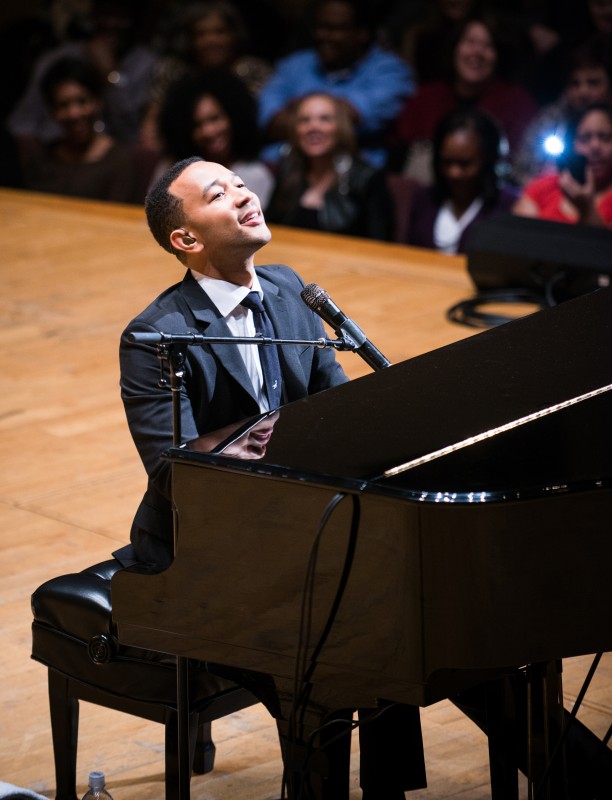
On Sunday, January 19, the eve of the Rev. Martin Luther King Jr.’s national holiday, more than 1,000 people, many of them University of Alabama students, filled the Frank M. Moody Music Building to hear a lecture and the music of Grammy Award winning singer/songwriter/humanitarian John Legend.
“I’m especially honored and humbled to be here to celebrate one of my personal heroes,” Legend said, acknowledging his amazement that so many people would come out to see him in “football country,” when there was an NFL playoff game on television.
“We take this time every year to recognize his incredible work, the spirit of his work and the impact of his work and think about how we can live our lives in a way that honors his legacy,” Legend said. “We know that you young people are next in line to carry on his work. Now I know that might sound like a daunting task, but I think you’re up to it.” Legend speaks at colleges and universities around the world and is always impressed about the readiness of students to take on the world’s challenges.
“We’re here today to talk about something bigger than ourselves individually. We’re going to think about how we build a better community and build a better world,” Legend said. “We also have a piano here, so maybe I’ll sing a little bit after I’m done.”
Before he was done talking he had admonished students to realize that being in college is a gift not to be taken lightly.
“It is expensive and it is difficult. Many of you overcame significant obstacles just to be here today,” Legend said, recalling his own college career and how few of those in his freshman class ended up in his graduating class. “The reason why you’re here is so you can become a better thinker. You gain the ability to think critically, to question the status quo, to challenge yourself and to challenge the ideas that you hear from other people.”
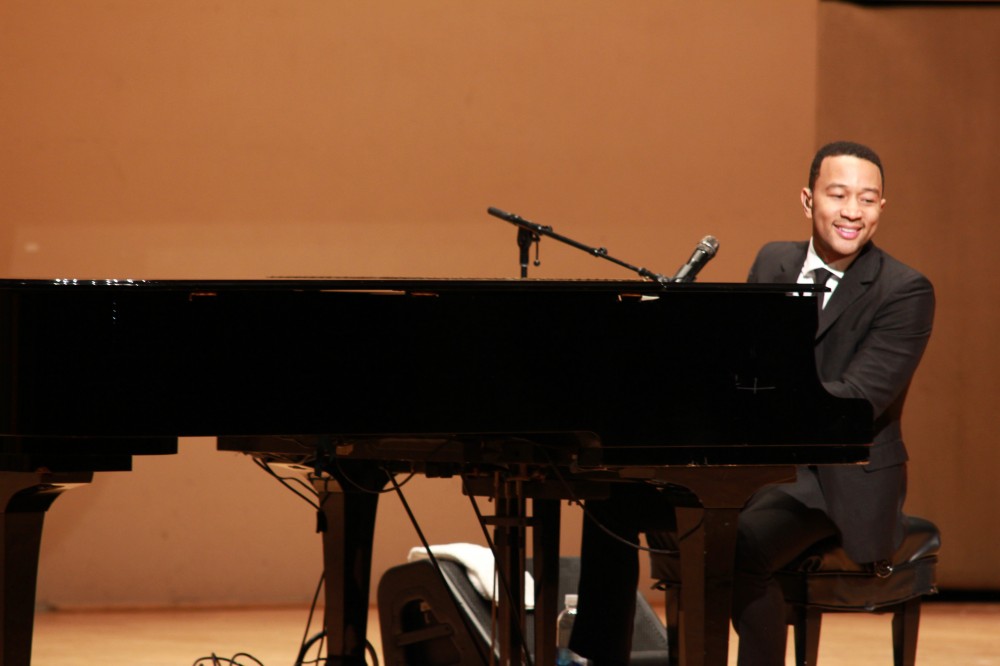
Although King was an activist and a revolutionary, Legend acknowledged that King had to be aided by bold politicians like President Lyndon B. Johnson to make these changes law.
Legend called education inequality today’s civil rights issue.
As the salutatorian of his high school class in Springfield, Ohio, Legend said he realizes that had he not received his education at the University of Pennsylvania, where he released his first album, his life would have turned out differently.
“One of the greatest things about an education is that it gives you control over your own destiny,” Legend said, stressing how hard it is for poor children to get a quality high school education and that for many of them a college education is out of reach. “It remains a gift to some, when it should be a right to all. These statistics are a call to action.”
He challenged today’s college students to get involved as activists and politicians and as community leaders. He told them to look at their resources and extra curricular activities and see if they could use their extra money and time to make a difference in the would around them.
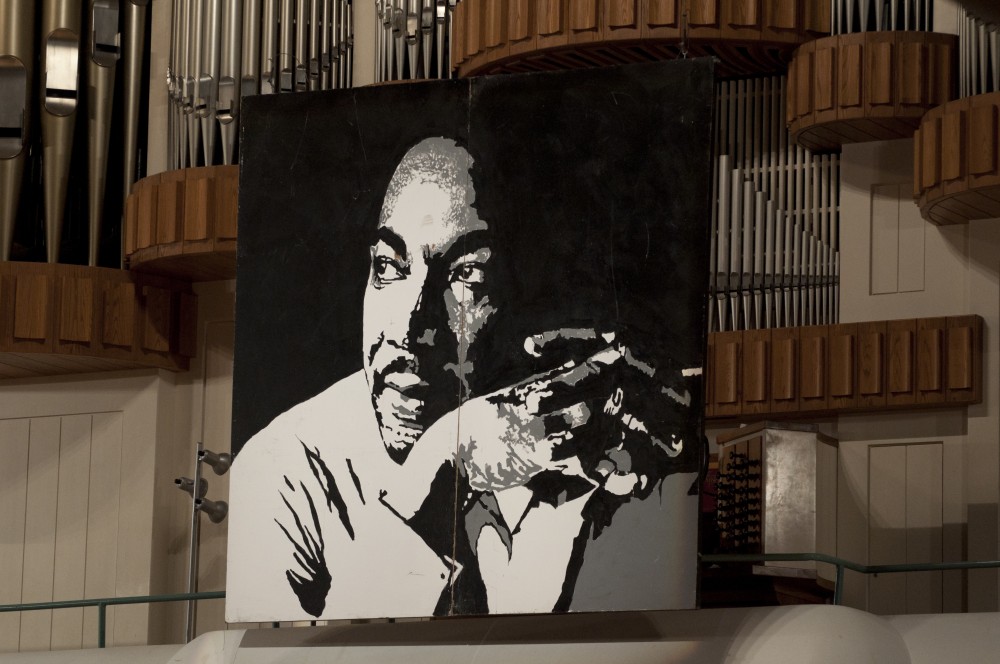
This self-examination led Legend to support organizations like Teach for America and to start The Show Me Campaign. Founded in 2007, Show Me, works to break the cycle of poverty by supporting the help to provide every child with a quality education, spreading awareness about the issues and inspiring citizens to take action.
“As we celebrate Dr. King’s Legacy I’m here to motivate you to make a difference,” Legend said. “We have to talk about the problem so we can talk about the solution.”
Legend mentioned not only education, but also mass incarceration of our young men and the plight of the working class.
“When you are fighting for something important it will not always be popular in the beginning,” Legend said reflecting on King’s life and the hurdles he had to overcome. “There is so much opportunity for you to make changes.”
Legend entertained the crowd with his music, beginning with a cover of “Wake Up Everybody,” a song that focuses on social activism and education. “When you teach children, teach them the very best you can,” he sang. “When you teach the children, teach ’em the very best you can. The world won’t get no better if we just let it be, na, na, na. The world won’t get no better, we gotta change it, yeah. Just you and me.”
In addition, he preformed crowd favorites, such as “Tonight” and “Save Room.” The crowd applauded enthusiastically and often and several attendees said the University made a good decision to bring Legend to campus for the Realizing the Dream celebration.
(Following is a transcript of John Cochran’s speech at the Legacy Banquet in Foster Auditorium, January 17, 2014. Cochran is a native of Montgomery and a graduate of the University of Alabama. The veteran broadcast journalist has worked for both ABC and NBC News.)
I must tell you I was surprised to be asked to speak here tonight. Usually when I come to Tuscaloosa to speak I talk about politics or I tell stories about presidents I have covered. Sometimes I just tell Bear Bryant stories. Those are the ones that go over best. But tonight, it’s different. Tonight we are in Foster Auditorium, for goodness sake. Foster Auditorium, a landmark historical site in the struggle for civil rights.
So, what on earth am I doing here? I was not a civil rights activist. I have always been a journalist, a reporter, and reporters are observers. We only watch and report what we have seen.
And on top of that, I never reported on civil rights stories in my own country. I have only reported on the fight for human rights in other countries, in Eastern Europe, Africa and Asia.
But I do have some credentials to be here. Because I was lucky enough to grow up in Montgomery, where the civil rights struggle really took off in the 1950s.
I want to talk about some people on both sides of that struggle — people I knew.
First, a woman named Arrie. An unusual name, I suppose. Spelled A-R-R-I-E. I last saw her more than 50 years ago … but I will never forget her.
In the mid 1950s she worked for my family as a maid. She was African-American. Arrie was, I guess, around 50 years old, maybe a bit older. She was an imposing woman, tall, erect. Wore glasses. Always dressed well, especially for someone who did not make a lot of money.
I did not know much about her home life. For the most part, she liked to keep her private life private. She was either divorced or a widow. She had a daughter in high school. She was very well spoken. It was always clear that she was intelligent.
If there is one word I would use to describe Arrie it is … dignified. I have been around presidents, prime ministers and captains of industry. But I have never known anyone with more dignity than Arrie.
So let’s set the stage. It is December 1, 1995. Late in the afternoon a very tired black woman takes a seat on a municipal bus. Her name is Rosa Parks. She works as a seamstress at a downtown store. She is also secretary of the local chapter of the National Association for the Advancement of Colored People. I’m sure you all know her story. The driver orders her to move to the rear. She does not. She is arrested.
She and others in the Civil Rights Movement had wanted a test case in the courts to challenge the state law requiring segregated seating. The federal government had already outlawed segregation on interstate travel. But black leaders wanted not only a test case, they also wanted to test the resolve of Montgomery’s white merchants by putting economic pressure on the white establishment.
Now, let’s look at what the Alabama law said. It basically said passengers had to sit where the bus driver told them to sit. But in actual practice it was not necessary to do this.
Whites knew the custom was for them to sit up front. Blacks knew they were supposed to sit in the back.
But here is where it gets even weirder. There was no line on the bus separating whites from blacks.
A clear line on the floor of the bus would have at least made some kind of perverted sense. But, in practice it was even worse. The custom was that whites, looking for an empty seat, could go as far back as they wanted. And if a white person reached the first row where a black person was seated, the black rider was expected to get up and move to the back.
Just think about that for a second.
You English majors have probably read Ernest Hemingway’s “Movable Feast.” Well, this was a moveable line. And Rosa Parks wasn’t having any of that when the bus driver told her to give up her seat. She had already had a run-in with the same driver some years before. And so, the bus boycott began.
It meant that blacks stopped riding buses, which were their principal mode of transportation. It meant that many of them were not able to get to the white-owned stores to buy things. It also meant that many domestic workers, mostly black women, could not get to work. A young black minister was chosen to lead the boycott, Dr. Martin Luther King Jr.
And that brings us to Arrie. She told my folks that she was going to do anything that Dr. King told her to do. She said that some blacks had formed car pools and she could get a car pool to take her to work in the mornings. But there was no car pool to take her home at 5 in the afternoon. So, she told my folks, it was up to them to find a solution.
And they quickly decided on a solution. Me!
I had just gotten my driver’s license, so every day after I got out of school it became my job to drive Arrie home.
How many of you have seen the movie, “Driving Miss Daisy”? It won an academy award several years ago. In it a black chauffeur played by Morgan Freeman drives Miss Daisy, an elderly white woman. He sits up front to drive; she sits in the back.
That was the way it was supposed to be in the South. Blacks and whites were never supposed to sit together. It was a rule. An unspoken rule, but a rule nonetheless.
So, when I would drive Arrie it was “Driving Miss Daisy,” only with the roles reversed. I was up front; Arrie was in the back. That went on for a few weeks until one day Arrie and I were walking out to the car, and she said, “Johnny, this is damn foolishness. I’m going to sit up front with you.” I said, “Well, all right Arrie. Whatever you want.”
So we would drive first through a white neighborhood, and people would stop and stare. They had never seen this before.
Then we would get to a black neighborhood where Arrie lived and even more people would stop and stare. This went on for a couple of months.
Then, one day Arrie and I had noticed that no one was paying attention to us anymore. People had gotten used to seeing us. The rule was no longer a rule.
But there were plenty of other rules. Let me go back a bit to when I was about 10 years old. Down the street from us was an elderly woman who employed a black maid. The maid had a son about my age and sometimes she would bring her son to work with her. His name was Benny. One day he walked across the street to a park where I played sandlot football with some other white kids. We asked if he wanted to play with us. He said sure, and for several days he joined us.
But one day he was not there.
We asked his mom where Benny was. She said she had left him at home and he would not be playing with us anymore. The woman she worked for had gotten a lot of anonymous phone calls saying we shouldn’t be playing together. The problem apparently was that we were playing a game where we touched each other. We not only touched, but we blocked and tackled, and knocked the stuffing out of each other. It was football after all.
Apparently if we had been playing some other kind of game, like croquet, it would have been OK because there would be no touching. But we did not play croquet in my neighborhood, and I never saw Benny again.
One thing you can say about the Deep South in those days, it was like living as a character in a play by Beckett or Pirandella — the theater of the absurd.
So back to the bus boycott and more theater of the absurd, that invisible but moveable line on buses.
When the boycott started, Dr. King and other leaders had offered a compromise. They said put a real, visible line separating black seating from white so that when the white section was full, then whites would have to stand up instead of taking seats from blacks. The white city fathers turned down the compromise.
A year later the U.S. Supreme Court ruled that any segregation on city buses was illegal. There would be no lines, visible or invisible. And from December 1956, blacks could sit wherever they wanted.
It was a total victory for Dr. King, but it did not come easily. Many blacks literally wore out their shoes walking to work or to school. Houses were bombed. Dr. King and others were put in jail. Some blacks lost their jobs because their white employers were vengeful. And some, like Arrie, felt they might lose their jobs but went ahead anyway.
Once city buses were integrated, many whites, not all but many, wondered why they had fought it so long. The unthinkable had become not only normal, but routine.
The same would happen six or seven years later with school desegregation. I was just about to start high school at Sidney Lanier High when the Brown vs. Board of Education decision came down from the Supreme Court. I remember at the time some whites saying the first black kid that steps inside Lanier will be a dead kid. But that’s not what happened.
In Montgomery black and white leaders worked hard to prevent violence and they succeeded. Of course, over time many white parents took their kids out of public schools and put them in white academies. But at least violence was avoided.
And not all efforts at integration were successful. When my younger sister, Mary Ann, was in high school, she heard Dr. King speak and was very much taken with the civil rights movement. I was already living up north. Mary Ann was and is very religious. She has always asked, “What would Jesus do?” And so at the age of 16, she tried to integrate our church. One Sunday morning she took the hand of one of Dr. King’s top lieutenants, the Reverend Ralph Abernathy, and walked with him up the stairs of the First Baptist Church. An ABC News camera crew was filming what could possibly be an historic moment. High drama, or so it seemed.
But when the church ushers saw what was coming, they shut the doors and one of them said to my sister: “Mary Ann, does your mama know what you are doing? What’s the matter with you? Get on out of here, now.”
And so, with the doors shut, she and Dr. Abernathy retreated in ignominious failure. No history was made that day. But I was proud of her for trying. And she was the lead story on the National ABC News that night. She later spent several years working with the Southern Christian Leadership Conference and was firebombed out of the house where she was living in Tennessee.
Of course, the first attempt to integrate this University also ended ignominiously. You are all familiar with Autherine Lucy, who was actually admitted in 1956 but then was suspended and eventually expelled on the flimsy excuse that her presence endangered her and others. It was not a proud moment for the university or those who loudly protested her admission.
It took seven long years before Vivian Malone and James Hood tried to enroll.
Last year the university marked the 50th anniversary on several occasions and one of the speakers was former Governor George Wallace’s daughter, Peggy. Let’s take a look at Wallace.
I first met him during his first run for governor in 1958. Some of you younger folks may not know it, but in that race he was the nearest thing to a liberal or at least a racial moderate in that race. He did well in the Democratic primary, but lost in a run-off to a man who was backed by the Ku Klux Klan.
At the time the Klan still had some influence. I well remember the first time I drove from Montgomery here. On approaching the Tuscaloosa city limits one of the first signs I saw was one that said, “The Ku Klux Klan Welcome you to Tuscaloosa.”
Now wasn’t that nice of the Klan? That sign stayed there for several years.
While I was a student here, I worked at a downtown radio station that no longer exists. I discovered one day that my boss, the general manager, belonged to the Klan. I was stunned. I told him that I had never heard him say anything racist. He just laughed and said, “Oh. The Klan. I just did that because it’s good for business. I don’t go to their meetings. But some of them have businesses that advertise with us.”
And the Klan was a factor in defeating George Wallace. He decided that in the next election he would play the race card and he did, successfully. He was elected in 1962. I was a student at the time having come back after serving in the Army. I had been stationed at the White House where I wore civilian clothes and worked for President John Kennedy’s press secretary.
My job was a technical one, to make audio recordings of the president and to deal with anything related to audio such as microphones and public address systems.
I’m wandering off topic here, but I want to tell you about the night President Kennedy spoke to a pep rally here in Foster. Kennedy and I were in New York at the Waldorf-Astoria Hotel where Coach Bryant accepted the award for the nation’s best football team. At one point during the banquet, the president, Coach Bryant and I, along with some trustees and famous alumni, went upstairs to a suite where we had set up a telephone line to Foster.
The auditorium was packed with students. Kennedy got on the phone and went on and on about how when he was at Harvard in the 1930s, he followed the exploits of the Alabama Crimson Tide. I was standing beside him and I still have a picture of the two of us. I have sort of a quizzical look on my face. Frankly, I doubted he had spent any time at all at Harvard following the Crimson Tide. But the folks here at Foster loved it.
But now let’s move ahead a year later. I am back in school here. And Wallace has just been elected governor.
One afternoon I was in class at what used to be the Union Building. It’s now Phifer Hall. The Dean’s secretary comes into the classroom and says, “John, you have a call from the White House.” So I went to the Dean’s Office and on the other end of the phone was the White House photographer, Cecil Stoughton. Cecil said, “I just saw a pal of yours walk into the Oval Office.” I said, “Who?” He said, “The president of your school, Frank Rose.” I said we were hardly pals and that he didn’t even know me.
After Cecil and I chatted a bit, I hung up and called Dr. Rose’s office. I smelled a good news story here. I was an aspiring journalist and wouldn’t it be great to break a story like this. I asked President Rose’s secretary if he was in his office, and she said, “No, he is on fundraising trip in Houston, Texas.”
I said I didn’t think so, that he was actually in the Oval Office talking to the president. She said … just hang on a minute. It was more like 3 or 4 minutes and then she came back and said could I get over to the president’s office immediately? The number two official at the University would like to speak to me. He was a very nice man named Jefferson Bennett. He said “John, you love this university, don’t you? And you wouldn’t do anything to harm the University, would you? But if you go public with this it will infuriate George Wallace. If he knows Dr. Rose is meeting with John and Robert Kennedy to discuss how to integrate this school, Wallace will be very vengeful toward the University. And so will some people in the state legislature.”
So, I had to decide between my ambition to be a journalist and loyalty to the university. I think it was a close call for a few minutes, but I decided to keep my mouth shut.
I graduated a few months later, so I was not here the following June when Wallace made his infamous stand in the schoolhouse door. Our master of ceremonies tonight, Culpepper Clark, is the expert on what transpired then. And if you want to learn more I suggest you read his book entitled: “The Schoolhouse Door: Segregation’s last stand at the University of Alabama.”
As you know, Governor Wallace retreated that day and the students were admitted. Vivian Malone is no longer with us. She died in 2005. He sister, Sharon, spoke here last year. She is a prominent doctor in Washington and is married to the Attorney General of the United States, Eric Holder. When I told her I would be here tonight, I asked if there was anything she wanted me to pass on for her on Vivian.
She wanted me to remind you that her big sister’s fight for civil rights did not end when she graduated in 1965.
Let me quote Sharon’s remarks about Vivian:
“The issue of civil rights was a lifelong commitment for her. From her first job in the newly formed civil rights division of the Justice Department to her last job as the head of Civil Rights and Urban Affairs at EPA, she continued the fight for civil rights for all Americans. As a testament to the strength of her spirit and to her continued presence, the new administrator of the Environmental Protection Agency, Gina McCarthy, has established ‘The Vivian Malone Jones Legacy Award’ which will be given to an EPA employee who has made exemplary contributions to social justice. And to close this historic arc, to ensure her safety and to protect her civil rights as a citizen of the State of Alabama, required the commitment and active participation of the president and the attorney general of the United States. And today my husband, Attorney General Eric Holder, has the responsibility and the privilege of enforcing those same civil rights. Fifty years has brought about many changes, and although we still have much work to do, I think Vivian would be extremely proud of where we are today.”
Those are the remarks that Vivian’s kid sister, Sharon, wanted to share with you tonight.
The integration of the University was a milestone. That very night President Kennedy went on national television and for the first time promised action on civil rights. He was the first president to say that civil rights was a moral issue. Until that night, Dr. King and other black leaders had been disappointed and frustrated by Kennedy’s reluctance to push for significant legislation. Kennedy did not live long enough to see his proposals become law. As you know, after his assassination Lyndon Johnson managed to persuade a reluctant Congress to pass bills banning discrimination in housing, public facilities, interstate commerce, and perhaps most important of all, a bill guaranteeing the right to vote.
At the time white Southerners were very powerful in Congress. They warned Johnson that if he continued to push for civil rights, then Democrats would lose the South. Johnson said he realized that but he had to do it.
Why did he have to do it? Well, partly he felt he had an obligation to carry out John Kennedy’s program. And as Johnson’s biographers have written, he had long felt that he had to help minorities. As a young schoolteacher in Texas, he saw discrimination not only against blacks but also Hispanic kids.
Recently, some of us who served in John Kennedy’s White House had a dinner on the 50th anniversary of his assassination. Because Lyndon Johnson also served in that administration as vice president, his daughter, Lynda Bird, was invited. I asked her if there was an additional reason that her father fought so hard for civil rights.
She immediately said yes, that before he became president, the family had a black man working for them at their house in Washington. He was very close to the family. One night at his home he became very ill and an ambulance was called for. But no ambulance came because he was in a black neighborhood.
Lynda Bird said her father was furious, never forgot it, and when he became president he did something about it.
When you look back at what resulted from the confrontation outside this auditorium, it is quite remarkable. One thing that happened is that it propelled George Wallace into the national consciousness.
I had some more dealings with him and so did my family. My much younger brother was in junior high school with Wallace’s son, George Jr., who as you know later became a politician himself. One day my mother got a call from the school saying my brother had gotten into fight with the governor’s son.
Some years later Wallace was starting his second run for the presidency. I went down to Montgomery to interview him. And when I walked into his office, I said, “I’m not sure you remember me.” He said, “Yeah, I remember you. You’re the guy whose brother beat the hell out of my kid.”
I crossed paths with Wallace several times over the years. In 1972 he was shot and paralyzed in a Maryland suburb just outside Washington. I covered that as a reporter, but privately I also met at the hospital with his second wife, Cornelia, whom I had grown up with. It was a terrible time for them. He was in severe pain and deeply depressed.
But while he was in the hospital in Maryland, he was visited by a black congresswoman, Shirley Chisholm from New York. Here is her account of their meeting. He told her that her supporters would not like the fact that she came to see him. She said she didn’t care what they thought. At that, he cried and cried and cried.
Some years later I was in Montgomery to visit my mother and his third wife called me. She asked if I would come by the governor’s mansion. She said it might cheer him up.
So I did and was taken up to his bedroom where he was in his hospital bed watching the news on TV. The national news was just ending and the local and state news was just starting. I said, “Governor, you want to watch this. I’ll just sit here and watch it with you.” “No,” he said, “I don’t care about this, I only care about national and international news,” and he clicked off the TV set. He still thought of himself as a national political figure even though in reality those days were long gone. He wanted me to tell him the latest in Washington politics and gossip.
We talked for about an hour. I don’t remember much about it, but I do remember we spent a long time talking, of all things, about 19th century European history. Any of you students majoring in history will appreciate this. He loved history, and he started talking about the Congress of Vienna in 1815 after Napoleon’s defeat at Waterloo. Wallace talked about the diplomats there, Talleyrand from France and Metternich from Austria, and so on.
After a while I felt he was tiring, so I took my leave. But I remember walking down the steps from the mansion and thinking, “Well, that was pretty weird.”
The next time and last time I saw him was when my wife, Barbara, and I were visiting my mother. Wallace was no longer governor. He was divorced and lived alone except for a young black man on whom Wallace was totally dependent.
We spent an afternoon at his bedside in his home. Barbara had never met him, and he spent much of that time trying to convince her that he had never been a segregationist. He rarely looked at me. We had known each other too long and he knew he could not convince me. But I do think his views changed after he was shot.
When he died, ABC asked me to cover his funeral even though it had nothing to do with my job of covering the White House. Wallace lay in state in the Capitol just a few steps from where Jefferson Davis as sworn in as president of the Confederacy. I was just outside with my camera crew interviewing people after they paid their respects. Many were black people who appreciated that in his last term Wallace had put many blacks in state jobs. Finally, one very sophisticated looking young black woman came out. I asked why she had come. She said, “I wanted to see up close the face of evil.”
Before I leave the subject of Wallace, I want to relate to you a story that a well-known African- American, Vernon Jordan, tells. Vernon is a past president of a civil rights group, the Urban League, and is now a prominent lawyer in Washington and New York. He is also known as perhaps Bill Clinton’s closest friend.
Eight years after Wallace was shot, Vernon was shot by a white supremacist. He almost died. The first telegram of sympathy Vernon received was from Wallace.
A few years after he was shot, Vernon was asked to speak in Montgomery at a predominantly black high school. Just before he started to speak, Vernon saw state troopers pushing Wallace’s wheelchair into the auditorium. Vernon went ahead with his speech, which was critical of Wallace’s policies.
After Vernon finished, the Troopers carried Wallace’s wheelchair up to the stage.
Vernon went over to him, and Wallace said, “I can’t get out of this chair, so I want to ask you a favor. I want you to reach down and hug me.” Vernon did. Now I want to quote to you some remarks that Vernon sent me when I told him I would be with you tonight. This is Vernon speaking now:
“This is the absolute, God-honest truth. The former governor of this state, a mean old racist who once stood in the schoolhouse door to keep out the black people, could no longer stand at all. And yet, he wished he could stand — not to set himself defiantly athwart history —but rather to embrace me as a brother. I tell you that was one hell of a transformation.” Those are Vernon’s words. He thought you might want to hear them.
You will be glad to hear that I am moving into the home stretch with my remarks. But since we are celebrating Dr. King’s birthday Monday, I want to talk about his impact that I saw overseas. In Poland in the early ’80s, the Communists declared martial law and imprisoned many anti-communists. During that time I met secretly with some who had escaped capture. They were not discouraged. They knew they would win in the end. They told me, “Look at how long it took Martin Luther King.” And they were right. Seven years later the Communist regime collapsed.
In the mid-’80s in South Africa, the white government also declared martial law. I heard the same things there. “Dr. King overcame. We will, too.” Next to Nelson Mandela and possibly Mahatma Ghandi, I believe he was the person black South Africans most admired.
And in this country Dr. King’s struggles spurred others to fight for women’s rights and gay rights. And how about the disabled? It took a quarter century after the Civil Rights Acts of the ’60s, but after a long hard battle, the disabled in 1990 won their fight in Congress for the Americans with Disabilities Act.
Young people may say the battles have all been won. There is nothing left to fight for. Wrong! Here’s just one example. Lately there have been attempts to suppress the votes of minorities. Now there is a fight worth getting into.
And it started all those years ago in Montgomery. So, I am honored to take part in Dr. King’s birthday party. But, as a Montgomery boy, I also want to remember all the people who took part in the historic bus boycott, especially Rosa Parks and my driving partner, Arrie.
I met Rosa Parks once when she was receiving an honor at the White House. I said, “We’re from the same town, Montgomery.” She just laughed and said, “Montgomery… my, my. My, my.”
She eventually moved from Montgomery, ending her days in Detroit. So did Arrie, who had relatives in Detroit. I know that they knew each other in Montgomery, but I have no idea whether they got together in Detroit.
But I like to think they did. I like to think of them in old age, sitting in their rocking chairs, just sitting and rocking, and looking back at their part in how they changed the world.
My, my. My, my.
Thank you.
AUBURN — Auburn University’s College of Liberal Arts, in conjunction with its Community and Civic Engagements Initiative, has announced its second annual Academy for Civic Professionalism, to be held May 11–14, 2014 in the Auburn Arena, 250 Beard-Eaves Court.
This event includes workshops, sessions directed by AU engaged scholars, and site visits. Keynote speakers are Harry Boyte, senior fellow in the Humphrey School of Public Affairs at the University of Minnesota; Julie Hatcher, executive director of the Center for Service and Learning at Indiana University-Purdue University Indianapolis; and Lorraine McIlrath, director of the Community Knowledge Institute at the National University of Ireland.
The academy is designed for academics and others in the arts, humanities and social sciences interested in civic professionalism and its incorporation into research, teaching and practice.
Among the academy’s purposes are: promoting civic professionalism; encouraging faculty to rethink teaching strategies with a focus on civic professionalism; to develop an emphasis on ethics and responsibility as they pertain to knowledge and application; to provide resources and support for engaged faculty.
Cost is $1,950 per person and includes instructional materials, on-site faculty coaching, access to planning tools and resources, a half-day site visit to a community partner, a reception to network with K-12 teachers and community leaders, and breakfast and lunch each day.
The ACA is limited to 25 participants. The deadline to apply is February 28, 2014. Submissions should include the application form, CV, statement of interest, copy of syllabus and letter of support. Submit applications to clacce@auburn.edu.
For more information, visit www.auburn.edu/cce/acp or contact Dr. Giovanna Summerfield, associate dean for Educational Affairs, at summegi@auburn.edu or 334-844-2890.
By Kirsten J. Barnes
CCBP Graduate Assistant
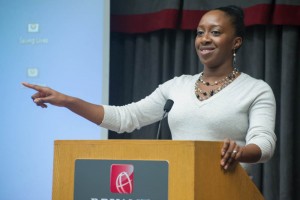
On December 12 at the Bryant Conference Center, the University of Alabama and its community partners concluded a second successful year in the faith-based and wellness program known as Saving Lives with a banquet to honor participants and welcome new members.
Three new churches — Hightown Church of God, Mount Pilgrim Baptist Church and New Zion Missionary Baptist Church — attended the banquet. The three original churches in the program are Plum Grove Baptist, First African Baptist and College Hill Baptist. Each was well represented at the banquet.

By the end of the year, six churches will be involved in the program, according to program leaders.
“Many of us may not be disciplined enough on our own to take care of our personal health,” said Carol Agomo, Saving Lives coordinator and program coordinator in the Division of Community Affairs. “With the Saving Lives initiative we recognize that spiritual health and physical well-being are intimately connected and that each strengthens the other.”

Agomo said the roles of the churches and the advocates have evolved during the almost two years since the program began, creating a Saving Lives network.
“What a night this has been, what a year this has been,”said UA Vice President of Community Affairs Dr. Samory Pruitt. “As a group we’ve learned a lot together. We’ve learned from each other and we’ve done it together.”
Pruitt said the groups have benefited from educational discussions concerning diet, exercise, relaxation and simply how to talk with their doctor.
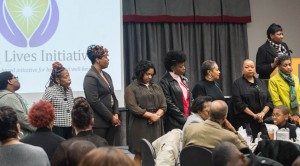
The celebration included songs from Plum Grove and College Hill choirs, as well as testimonies on the successes of the program from members of each church.
When individuals engage in improvement opportunities like those provided by Saving Lives, they can measurably improve their health, said Dr. Rebecca Kelly, director of UA’s Office of Health Promotion and Wellness, who has been one of the key instructors at Saving Lives workshops.
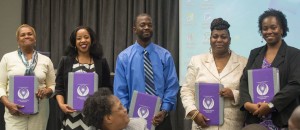
Dr. Pamela Payne-Foster, M.D., deputy director for UA’s Rural Health Institute for Clinical and Translation Science, said Saving Lives exemplifies UA’s efforts to help those in the African American community live more abundant lives. “This is a partnership that is intentional,” she said. “We intentionally chose faith-based communities within the larger Tuscaloosa African American community. We understand the importance of spirituality when we talk about health and really what spirituality means in our efforts to decrease high morbidity and address health disparities.”
Georgia White, an advocate from First African Baptist Church, said she was glad that her pastor, the Rev. Richard L. Morgan, accepted the challenge. “I just want to say that we have really learned a lot these last two years. It has been a rewarding experience for all of us. We’ve worked together and discussed what we want to do for the upcoming meetings. Everyone has just pulled together,” said White, a retired nurse.
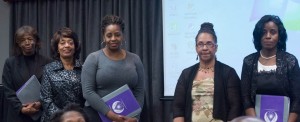
In addition to discussions and workshops on healthy living, some of the churches have started exercise groups and even purchased equipment to be housed at the church for the use of its members.
“The Bible has so much to say about the body. We are the body of Christ. Our Lord gave his body. John admonishes us to keep healthy bodies even as our soul prospers,” said the Rev. Tyshawn Gardner, pastor of Plum Grove Baptist Church, referencing the very scripture used by the printed program for the evening — “Dear Friend, I pray that you may enjoy good health and that all may go well with you, even as your soul is getting along well.” (3 John 1:2).
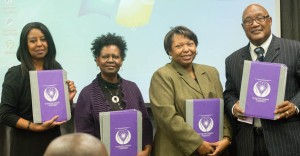
Gardner was one of the first pastors approached as plans were being made for the initiative. “When Dr. Pruitt called me, I was immediately on board. Not only because it is Biblical, but because it is the right thing to do,” Gardner said. “We have better informed elders now. They know what questions to ask during their monthly doctor visits. This program and initiative will not only increase vitality, energy, health and body, it also brings a sense of fellowship and wholesomeness to families striving to be obedient for our Lord.”
“I could not be more pleased with the work of the founding churches in the pilot program,” Pruitt said. “We now look forward to the new group of churches to begin participating in 2014.”
Master of ceremonies for the evening was Christopher H. Spencer, director of the Office of Community Development in the Center for Community-Based Partnerships, an initiative of the Division of Community Affairs. Spencer is also senior pastor of St. Matthew Watson Baptist Church in Boligee.
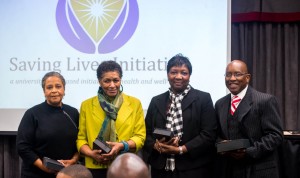
Spencer is one of the many ministers using the program to improve their own health and educating their congregations in the Saving Lives principles. Spencer has lost 25 pounds through the program and has pledged to lose 25 more this year. Others have lost even more since the program began.
“We want members to be happy physically as well as spiritually,” Spencer said. “Jesus met physical and spiritual needs, and that’s what this program does.” During each workshop, scripture is used to illustrate healthy lifestyles. “Each lesson has a spiritual background. Everything in the program is connected to scripture,” he said.
In addition to the workshops, the program requires that participants take part in health screenings and their results are tracked, showing the members how they’ve improved or failed to improve.
According to Dr. Martha Crowther, associate professor and director of clinical psychology at the University, health screenings are the first step toward a healthy lifestyle, providing a baseline for what improvements are needed.
Although the program is expanding to several new churches, pastors of the original churches will be a resource and mentors for the new churches, Spencer said.
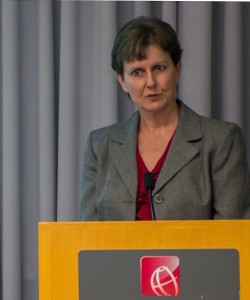
By Kirsten J. Barnes
At the Center for Community-Based Partnerships Council meeting at the Bryant Conference Center on November 14, members heard a discussion about several community outreach projects, listened as students discussed the research they presented at the 2013 Engagement Scholarship Consortium October 8–9 at Texas Tech University, and saw videos of the 2013 Magrath Award winners.
Dr. Samory Pruitt, vice president for Community Affairs, opened the meeting with a discussion of the C. Peter Magrath Community Engagement Award recipients. Although UA did not win an award, Pruitt highlighted the program in an effort to educate the group on the types of projects recognized and to motivate the group for future entries.
“For the first time they gave an award to institutions who used engaged scholarship to initiate programs with direct links to economic development,” Pruitt said, adding that the state is pushing higher education institutions to conduct more research in the area of economic development. “I’m interested in supporting efforts that fall into this category.”
Although the Magrath Awards are judged during the Engagement Scholarship Consortium conference, they are presented at the Associate of Public and Land-Grant Universities annual meeting, held this year Nov. 10-12 in Washington, D.C.
“Another award given for the very first time was for institutions who made a concerted effort to increase graduation rates for under-represented students,” Pruitt said. The winner in this category was Georgia State University.
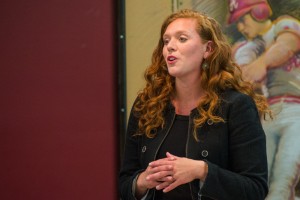
Following this presentation, Dr. Melanie Miller, director of student and community engagement, discussed the presentations from Scholars for Community Outreach, Partnership, and Engagement (SCOPE) students at the ESC conference.
SCOPE was formed nearly three years ago, but has taken on new framework and increased momentum over the past year.
“We are really excited about the progress that this group is making,” Miller said. “This year we have 32 members. They are undergraduates and graduates, and include first semester freshmen to those in the last year of their Ph.D. and from all disciplines.”
The students are all involved in community-based research at some level and this year 17 SCOPE students attended ESC, making presentations alongside nationally recognized scholars.
Four students who attended the conference discussed their experience.
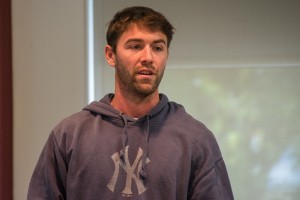
Anna-Margaret Yarbrough described her research on “how we can better engage with community partners,” adding that it was refreshing to meet so many students from other schools working on engaged scholarship. “I felt so fortunate being a part SCOPE knowing that I have the support of faculty and staff.”
Yarbrough recently had a manuscript accepted by the Journal of Community Engagement and Scholarship, published at UA.
Adriane Sheffield, a third year doctoral student in educational psychology and ESC Fellow, presented for the second year at the conference, this time twice. She presented a poster presentation Navigating the “Space Between” in a Community-Based Partnership” with Ryan Alverson, Cody Carter, Cecil Robinson and Brittney Brown. And she conducted a workshop Connection Instruction, Professional Development and Student Achievement: Partnering for Change,” with Dr. Sandra Colley Nichols of UA’s College of Education and Dr. Elizabeth Davis of the Tuscaloosa Public Schools System.
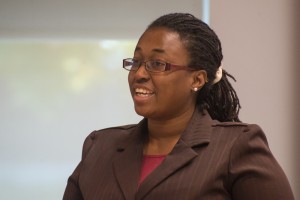
“I have thoroughly enjoyed being a part of SCOPE,” Sheffield said. “It allows me to focus on my passion, which is engaged research. I have become a cheerleader for SCOPE in the College of Education.”
The University of Alberta in Canada will host the 2014 ESC and Dr. Katy Campbell, dean and professor of Extension Faculty at the University of Alberta, will be the keynote speaker at the CCBP Awards program scheduled for April 18, 2014.
Additionally, Dr. Sherry Nichols of the College of Education made a presentation on creating a Makerspace Coalition in Tuscaloosa. Makerspaces allow people to come together to create things using tools provided by those working in the space. They can be anything from sewing and quilting spaces to painting and woodwork.
“They try to bring in tools that people may not have ready access to,” Nichols said, adding that she plans to partner with the Tuscaloosa Public Library to create a Makerspace that will teach students about bugs.
Finally, there was discussion regarding the charge of the 2013-14 UA Carnegie Reclassification Team to come up with a systematic way to collect data related to engagement.
“Our application is only going to be as good as the information we receive from you’ll,” Pruitt said. “Carnegie focuses on how institutions engage the community. We need to decide how we systematically come up with a way to collect this information.”